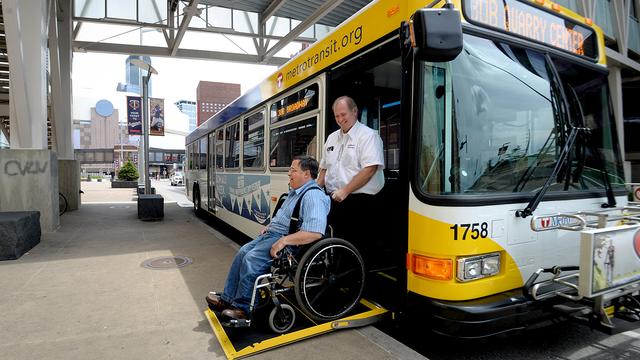transportation disparities in Minnesota. Photo: Metro Transit
Reliable transportation is a necessity for Minnesotans to get to and from school, work, and social activities, and many take it for granted that they can take a car or mass transit to get where they need to go.
But for others, the current transportation systems don’t serve their needs; they face disparities and barriers in reaching their destinations.
It will take more than just better roads, buses and bike paths to address those disparities, according to a new study by researchers from the University of Minnesota's Humphrey School of Public Affairs and Center for Transportation Studies (CTS).
The study concludes that larger social issues such as racial segregation in cities, the automobile culture, and lack of services for those with limited mobility, must also be addressed.
The study is one of the first steps in the Minnesota Department of Transportation’s new Advancing Transportation Equity Initiative.
The research team included Humphrey School Professor Yingling Fan, research assistant and PhD student Leoma Van Dort, and former Humphrey School research fellow Andrew Guthrie, who is now an assistant professor at the University of Memphis.
"The study will help us understand how the transportation system, services, and decision-making processes help or hinder people in underserved and underrepresented communities in Minnesota,” says Hally Turner, MnDOT's planning program coordinator.
The underserved and underrepresented include low-income neighborhoods, communities of color, indigenous communities, rural residents, older adults, people with disabilities, women and youth, and people with limited access to a car.
The researchers began by examining current research and practice in the field of transportation equity. They found that societal-level structural inequities make it harder for underserved residents to access regular, reliable transportation.
“Some of these structural inequities, such as racialized spatial segregation in metropolitan areas and auto-dependent development patterns, are built into the very fabric of our communities,” Fan says. “The user-pay principle that governs the current transportation finance system is viewed as another inequity, since it does not take into account users’ ability to pay.”
The researchers then explored 24 programs from across the United States that aim to improve transportation equity. The resulting report provides a baseline of knowledge about how well various remedies work.
Stakeholder engagement was an integral component of the study, says Gina Baas, CTS associate director and principal investigator. “We received key guidance from MnDOT, other public-sector agencies, and external community partners with expertise in addressing disparities and inequities,” Baas says. “We also engaged community members at a community event in Minneapolis to seek direct input from them about the day-to-day transportation challenges they face.”
Based on their findings, the researchers developed recommendations for MnDOT and other transportation partners to consider in advancing transportation equity. The recommendations address both societal inequities and the inequities of the transportation system itself.
Six themes for addressing transportation equity
- Engagement processes. Design engagement processes that facilitate community leadership and the inclusive participation of traditionally underserved and underrepresented communities, where community members drive conversations around their transportation needs and strategies for implementing solutions.
- Increased opportunities. Initiate programs and policies that increase access to social and economic opportunities, such as jobs, affordable housing, healthy food, education, health care, and recreation, particularly for underserved and underrepresented communities.
- Transportation for sustainability and health. Create policies and programs that support active transportation and provide safe, smart, and affordable transportation alternatives that minimize automobile dependency to create healthier, more sustainable communities.
- Equity spending. Integrate equity promotion as a standardized practice at the agency and program level, particularly in prioritizing spending across the system and distributing infrastructure projects.
- Collaboration and coordination. Collaborate and coordinate across transportation and non-transportation agencies, institutions, and organizations—including academic institutions—to advance equity.
- Evaluation metrics. Incorporate both quantitative and qualitative metrics for evaluating transportation programs and projects as well as their impacts on underserved and underrepresented populations
The report identifies which populations are most likely to benefit from each recommendation, along with what modes of transportation each recommendation affects.
“The study lays a foundation for MnDOT to work with transportation partners to meaningfully reduce disparities,” Turner says.
Another component of MnDOT's initiative is a Community Conversations Engagement project, a series of in-person conversations between the agency and individuals who work with and represent underserved communities throughout Minnesota. Those conversations will take place over the next two years.
This story was originally published by the Center for Transportation Studies


